Gladiolus are luxurious flowers that cannot but attract everyone’s attention. That’s just caring for them is quite difficult and requires year-round attention of the gardener. In particular, the harvesting period is one of the most important stages in the cultivation of these noble flowers. After all, the right time for harvesting corms and the very procedure for harvesting and drying determine not only the safety of planting material during the winter, but also the very possibility of germination and flowering of gladioli next year.
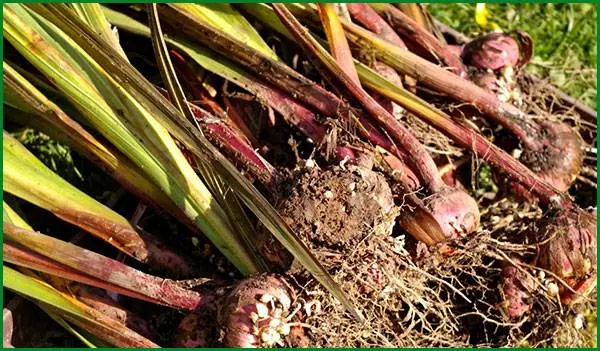
Terms of harvesting gladioli
Gladiolus are flowers that bloom quite late, in the second half of summer. Many late varieties can bloom even closer to autumn and in September. But at the same time, the corms and the flowers themselves cannot stand frost, so for the winter they must be dug up and stored until planting in the spring in a cool and relatively dry place. Experienced flower growers know that it is necessary to prepare gladioli for harvesting in advance, but beginners may well let them bloom until frost, so that they can quickly be dug up and sent for storage. Under no circumstances should this be done.
Attention! After flowering, it is vital for different varieties of gladiolus to be in the ground for 30 to 50 days in order to gain strength for flowering next year.
If this is not done and the corms are dug up ahead of schedule, then they will not be able to ripen well and will not even sprout next year.
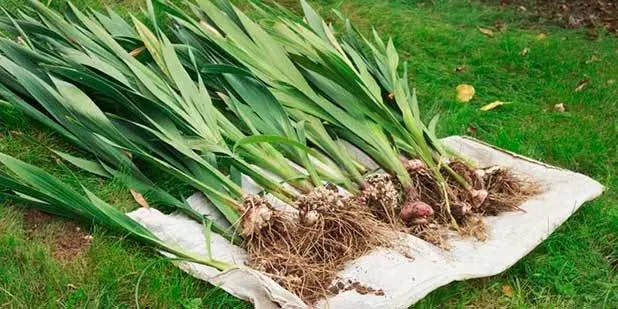
But, on the other hand, one should not forget about frosts, which can come in autumn at any time and destroy all the flowers and even corms in the ground. Of course, small frosts from 0 ° to -5 ° C are not yet terrible for corms, especially if the plantings are additionally insulated by covering them with any special material on top. But the onset of a period of stable cold weather, when average air temperatures drop below -5 ° C, is already a danger to gladioli.
Therefore, on average, the time for harvesting gladioli should be calculated based on the local weather conditions in your region. For example, if persistent cold in your area occurs in mid-October, then gladioli should be harvested in the first half of October. If we subtract 40 days from this period, it turns out that it is necessary to cut the flower stalks of all gladioli at the end of August, until the first of September, regardless of how many flowers have already bloomed by this time. In the southern regions, of course, the timing can be significantly shifted towards the winter period.

Early and mid-early varieties are harvested first, the corms of which ripen within 30-40 days after flowering or cutting of inflorescences. In late varieties of gladiolus, ripening can last 45-50 days, so they are harvested last.
Among the varieties of the same harvesting time, it is necessary to dig out the largest and most mature corms first. Gladiolus grown from babies (tuber buds) that may not have produced flowers in the current season are harvested last to give them more time to accumulate nutrients.
This sequence is explained by the fact that in plants obtained from mature corms, after the completion of the maturation of the children, both the roots of the first order and the mother bulb, and the roots of the second order, begin to die off faster. And this, in turn, increases the likelihood of penetration of Fusarium fungi and others into gladioli. The onset of rainy and cold weather at the end of summer and autumn only contributes to the spread of diseases.
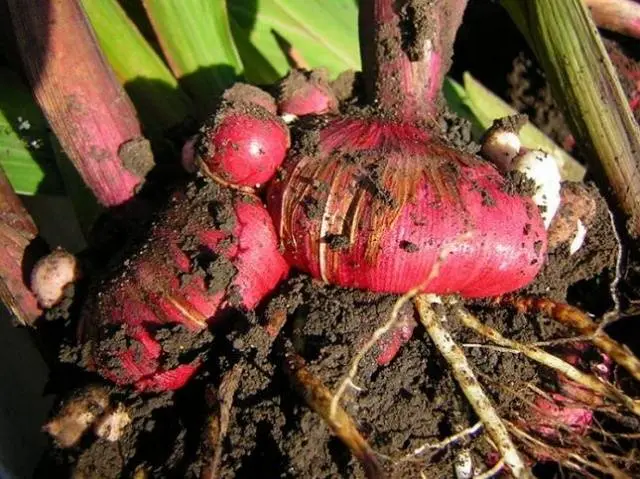
Important! Ceteris paribus, they try to remove the first varieties of dark-colored gladioli (purple, cherry, red), as well as blue ones, since it is noticed that they lose their immunity to fungal diseases earlier than others.
Of course, sometimes it is a shame to remove flower stalks from young plants, since often new varieties are bought precisely in the form of large children who are ready to release the first flower arrow only by the end of summer. If you need to see the first flower and check the correctness of the variety, then the arrow can not be completely removed, but leaving one bud below. When it blooms, it is quickly removed. In general, it is desirable to remove flower stalks from gladiolus immediately after flowering, because, being left on the plant, they lengthen the corms ripening time by 10-15 days.
Digging features
Harvesting gladioli is best done in dry weather. When digging up gladioli in damp and cool conditions, they can lose many babies. Some of them are able to successfully overwinter, especially in the southern regions, and next year it will be difficult to determine exactly which variety has sprouted.
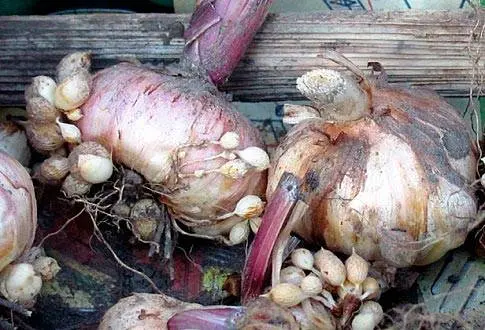
Comment! Remember that it is possible to grow gladioli in the same place only after three years, otherwise it will be difficult to fight diseases.
For harvesting gladioli, a shovel, wide-toothed fork, or even long-handled garden shovels are used. Forks are very convenient to use, but for those varieties of gladioli where the children are easily separated from the corm, it is advisable to use scoops to reduce the loss of children during digging.
Undermining gladiolus bushes, at the same time they check how the labels with information about the varieties are preserved, and the conformity of the variety is verified according to the spring planting plan. Plants are carefully removed from the ground and lightly shaken over polyethylene or tarpaulin from the ground and from the children. Sick and damaged corms are immediately set aside in order to burn them later. At the same time, all the children are carefully selected and laid out along with large bulbs according to varieties.
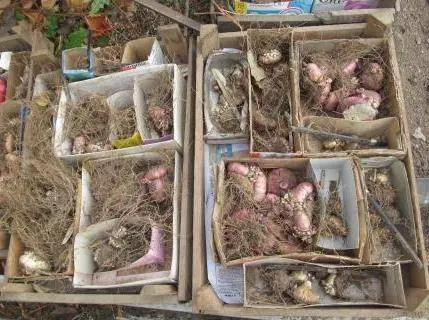
The stems of mature corms are cut off, leaving a very small stump (0,5-0,8 cm). This short pruning helps protect gladiolus from getting inside thrips, which by autumn tend to move closer to the base of the bulbs.
In large, mature corms, the old parent corm, as well as all roots, is removed at once. This reduces the spread of diseases, and also speeds up the drying time of the planting material.
At the time of harvesting, the mother corm breaks off relatively easily. If for some reason this was not done, then after a few days it will be difficult to separate it and it will be necessary to wait a few more weeks for a protective cork layer to form during drying.
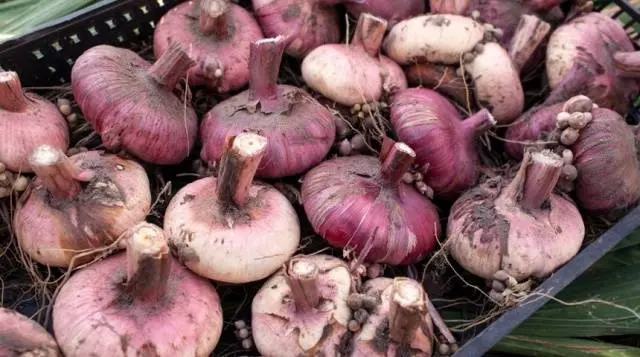
In young bulbs grown from children, the roots are not cut, but only shortened in order to remove them only during spring preparation for planting.
After removing all excess corms, they are thoroughly washed from impurities and treated in a solution of potassium permanganate (10 g per 10 l of water) for 25 minutes. In addition to potassium permanganate, you can use any fungicide, for example, Maxim.
Drying corms
If at the time of harvesting the weather is sunny and warm, then it is advisable to dry the corms sorted by variety for 1-3 days in the open air. After that, gladioli must be dried for two weeks at a temperature not lower than +20°C, and preferably +25°+30°C. This can be done by placing boxes with corms near heating appliances. At least once a day, it is desirable to stir the corms of gladioli to ensure uniform heating and ventilation.
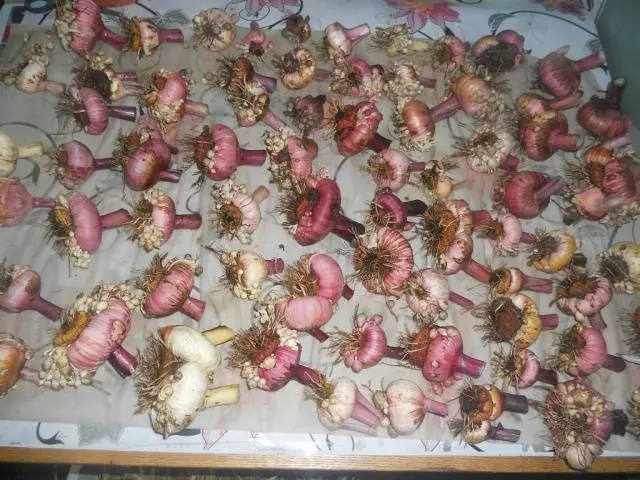
At the last stage of drying, the corms are placed in loose form in a room with a temperature of +20°+22°C and stored there for about a month. Only then can the gladiolus bulbs be put away for storage. If the corms are dried enough, then it is not necessary to remove the protective scales until spring. Moreover, they can play the role of protection against various external influences during storage.
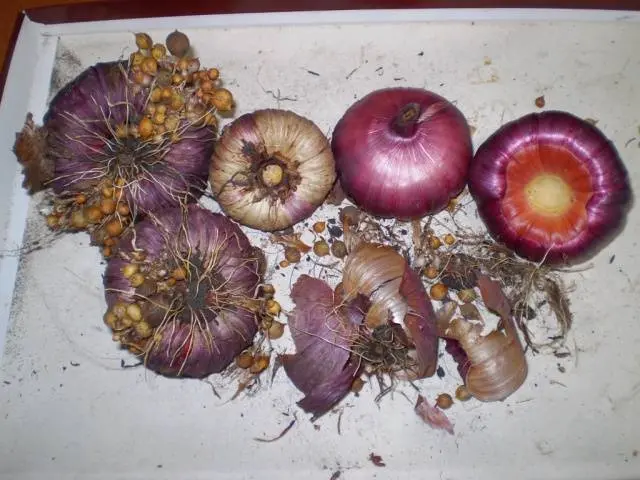
Only adult corms of gladioli need good drying. Children are separated immediately after harvesting, put in bags according to varieties and almost immediately put into storage in the lower compartment of the refrigerator.
Advice! To prevent diseases, peeled garlic cloves, which have antibacterial and antifungal properties, are placed in bags with gladiolus bulbs during storage.
Planting material of gladioli should also be stored after drying in a dry and frost-free place at a temperature of +3°C to +9°C. Once a month, the corms must be sorted out and separated from those that show signs of disease so that they do not have time to infect the rest.
Subject to all the above recommendations, gladiolus corms will be perfectly preserved until spring planting and will delight you with abundant flowering next season.









